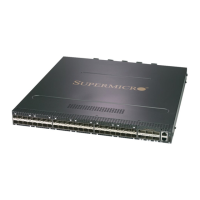Supermicro SSE-F3548S/SSE-F3548SR Configuration User’s Guide
5 MLAG
5.1 Overview
Typically data centers provide redundancy by means of oversubscription by connecting switches and
servers to dual aggregation switches. In such cases, Spanning Tree Protocol (STP) prevents network loops
by blocking half of the links to the aggregation switches. However this reduces the available bandwidth by
50%.
The Multi-Chassis Link Aggregation (MLAG) feature allows users to logically aggregate ports across two
switches. This provides increased bandwidth and redundancy.
There can be multiple MLAG interfaces between two switches. The maximum number of MLAG interfaces
is limited by the maximum number of LAGs supported in the switch models. Similar to the LAG, MLAG also
supports up to eight member ports.
The two switches that logically aggregate are called MLAG peer switches and communicate through an
interface called an Inter peer link (IPL). The IPL is primarily used to exchange MLAG control information
between peer switches, however it also carries data traffic for devices that are attached to only one of the
MLAG peers.
5.1.1 Terminologies
5.1.1.1 IPL – Inter Peer Link
The link connecting two MLAG peer switches is referred as an Inter Peer Link (IPL).
This link should be configured as a LACP port channel. It can have many member ports as supported by
the switch model.
5.1.1.2 Peer Switch
The two switches that form a single logical port channel interface is referred to as peer switches. The peer
switches are connected through the IPL interface. For example, in the topology diagrams shown in the
“Topologies” section, the switches “Switch A” and “Switch B” are peer switches.
5.1.1.3 MLAG Port Channel
The link connecting MLAG peers to MLAG partner switches is called an MLAG port channel. MLAG port
channel interfaces should be created on peer switches with the same port channel number.
5.1.1.4 Partner Device
The device connected to both the peer switches using a LACP aggregation link is referred as partner
device. For example, in the topology diagrams shown in “Topologies” section, the switch “Switch C” and
“Servers” are partner devices for MLAG switches.

